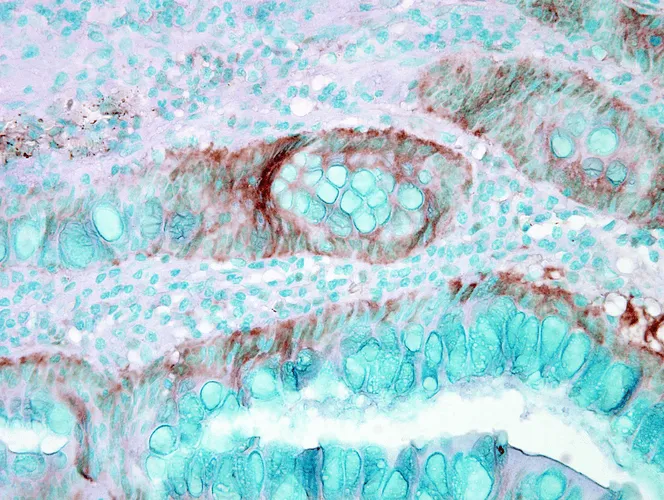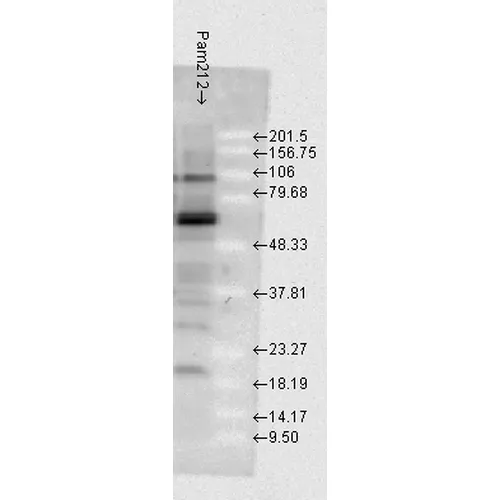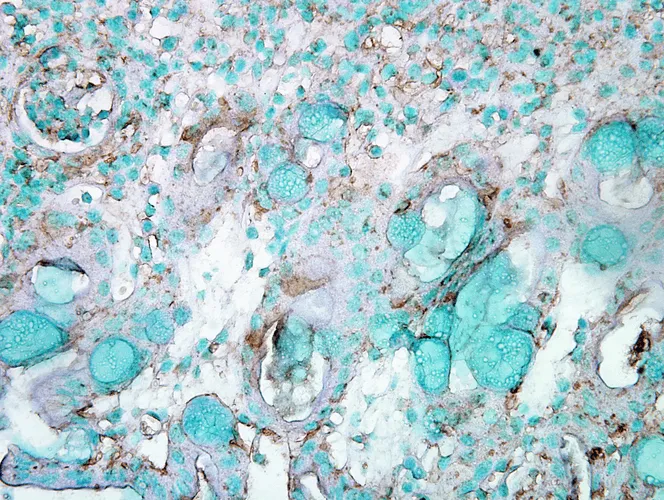HSP70 Antibody
CAT:
400-SPC-103D
Size:
100 µg
Price:
Ask
- Availability: 24/48H Stock Items & 2 to 6 Weeks non Stock Items.
- Dry Ice Shipment: No
















HSP70 Antibody
- Background: HSP70 genes encode abundant heat-inducible 70-kDa HSPs (HSP70s). In most eukaryotes HSP70 genes exist as part of a multigene family. They are found in most cellular compartments of eukaryotes including nuclei, mitochondria, chloroplasts, the endoplasmic reticulum and the cytosol, as well as in bacteria. The genes show a high degree of conservation, having at least 50% identity (1, 2). The N-terminal two thirds of HSP70s are more conserved than the C-terminal third. HSP70 binds ATP with high affinity and possesses a weak ATPase activity which can be stimulated by binding to unfolded proteins and synthetic peptides (3). When HSC70 (constitutively expressed) present in mammalian cells was truncated, ATP binding activity was found to reside in an N-terminal fragment of 44 kDa which lacked peptide binding capacity. Polypeptide binding ability therefore resided within the C-terminal half (4). The structure of this ATPbinding domain displays multiple features of nucleotide binding proteins (5). All HSP70s, regardless of location, bind proteins, particularly unfolded ones. The molecular chaperones of the HSP70 family recognize and bind to nascent polypeptide chains as well as partially folded intermediates of proteins preventing their aggregation and misfolding. The binding of ATP triggers a critical conformational change leading to the release of the bound substrate protein (6). The universal ability of HSP70s to undergo cycles of binding to and release from hydrophobic stretches of partially unfolded proteins determines their role in a great variety of vital intracellular functions such as protein synthesis, protein folding and oligomerization and protein transport. Looking for more information on HSP70? Visit our new HSP70 Scientific Resource Guide at http://www.HSP70.com.
- Description: Rabbit Anti-Human HSP70 Polyclonal
- Specifications: Detects a ~70kDa. May cross-react with HSC70 at lower dilutions.
- Product Name Alternative: Cancer, Heat Shock, Cell Signaling, Protein Trafficking, Chaperone Proteins, Cancer, Tumor Biomarkers
- CAS Number: 9007-83-4
- UNSPSC: 12352203
- Gene ID: 3303
- Swiss Prot: P0DMV8/P0DMV9
- Accession Number: NP_005336.3
- Cellular Locus: Cytoplasm
- Host: Rabbit
- Species Reactivity: Human, Mouse, Rat, Beluga, Bovine, Dog, Fish, Carp, Guinea Pig, Hamster, Monkey, Pig, Sheep, Coral, Plant, Shark, L. amazonensis
- Immunogen: Recombinant Full length Human HSP70 Protein
- Target: HSP70
- Clonality: Polyclonal
- Conjugation: Unconjugated
- Validated Applications: WB, IHC, ICC/IF, IP, ELISA, FCM
- Purification: Peptide Affinity Purified
- Concentration: 1 mg/ml
- Dilution: WB (1:1000), IHC (1:100), ICC/IF (1:100), IP (1:100); optimal dilutions for assays should be determined by the user.
- Weight: 0.1
- Buffer: PBS pH7.4, 50% glycerol, 0.09% sodium azide *Storage buffer changes when conjugated
- Precautions: Not for use in humans. Not for use in diagnostics or therapeutics. For in vitro research use only.
- References & Citations: 1. Welch W.J. and Suhan J.P. (1986) J.Cell Biol. 103: 2035-2050. 2. Boorstein W. R., Ziegelhoffer T. & Craig E. A. (1993) J. Mol. Evol. 38(1): 1-17. 3. Rothman J. (1989) Cell 59: 591 -601. 4. DeLuca-Flaherty et al. (1990) Cell 62: 875-887. 5. Bork P., Sander C. & Valencia A. (1992) Proc. Nut1 Acad. Sci. USA 89: 7290-7294. 6. Fink A.L. (1999) Physiol. Rev. 79: 425-449. 7. Hung T.H., et al. (2001) Am J Pathol. 159: 1031-1043. 8. Locke M. (2000) Cell Stress & Chaperones 5: 45-51. 9. Ianaro A., et al. (2001) FEBS Lett. 508: 61-66. 10.Trentin G.A. et al. (2001) J Biol Chem. 276: 13087-13095.
